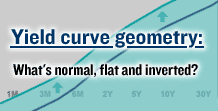|
Riding the yield curve
The curve briefly inverted for the first time in 5 years -- but does that mean a recession looms?
NEW YORK (CNNMoney.com) - For those who see the yield curve as a crystal ball for the economy, the so-called inversion in the Treasury market Tuesday could be seen as a bad omen. But before you rush to horde your money under the mattress in anticipation of another recession, relax. Unlike the last time the yield curve inverted in 2000 -- signaling the beginning of the post-bubble economic downturn -- this time around, market strategists are taking a glass-half-full stance on the prospects for the economy.
Earlier in the session, the yield on 10-year Treasuries temporarily fell below that of 2-year notes, a rare event because investors tend to demand higher yields on longer-dated bonds to compensate for the risk of higher inflation later. But the curve later reverted to its more normal status, with the 10-year yield at about 4.36 percent, above the 2-year note yield of 4.35, but just barely. The yield curve refers to the slope of rates in the Treasury bond market, and an inverted yield curve traditionally signals a slowing economy or a recession. According to a 2003 analysis by the Federal Reserve Bank of San Francisco, each of the six recessions since 1970 was preceded by a yield curve inversion -- an unnerving precedence. (For more on the geometry of the yield curve, click here). Exception to the rule
But there are always exceptions to the rule, said Stuart Schweitzer, global market strategist at JPMorgan Asset Management. In the past, whenever the yield curve inverted and a recession followed, both short-term rates and long-term rates were on the rise. This time, short-term interest rates have been climbing gradually while long-term rates have remained fairly flat, he noted, indicating financial conditions aren't as tight as they have been when rates were rising in the past. He added that inflation remains mild and the economy is growing at a surprisingly solid clip, despite concerns over high energy prices. "The economy is resilient. Christmas sales were fine, not outstandingly good, but solid," he said. "There's no evidence that a rise in interest rates is sufficiently damaging spending." Market observers said there could be some danger of an economic slowdown if the Federal Reserve decides to keep raising short-term interest rates aggressively. "The biggest risk in 2006 is that the Fed will be seduced by worries about inflation into raising rates too high," said Hugh Johnson, chairman of Johnson Illington Advisors. "A lot depends on what the 10-year does and while I would hope that they would take notice that it's going down in yield, the question is whether they will take it seriously or dismiss it." The Fed has publicly discounted the usefulness of the yield curve as an economic indicator, saying that other factors, such as a heavy flow of overseas capital into the U.S., have driven the yield on 10-year notes to abnormally low levels -- distorting the yield curve's predictive abilities. (Bond prices and yields move in opposite directions.) Fed Chairman Alan Greenspan earlier this year even called the persistence of low long-term Treasury yields despite rising short-term interest rates a "conundrum." But JPMorgan Asset Management's Schweitzer said there are signs that the Fed is getting close to the end of its rate hikes, though the market is generally expecting the central bank to raise rates at least once if not twice more, which would bring its benchmark fed funds rate to 4.75 percent. Schweitzer said he expects the yield curve to invert intermittently in 2006 and economic growth could slow for a while, especially when "hurricane reconstruction spending has peaked." No need to run and hide
So what should skittish investors do as the yield curve bounces up and down? Sit tight for now. Market strategists see little reason to change investment strategies, particularly when it comes to investing in financial institutions and securities firms, which are most severely impacted by the movements of short- and long-term rates. "People have been watching the yield curve for quite a while and have baked in the possibility of an inversion," said David Easthope, analyst at Celent LLC, an independent research and consulting firm. "I don't get the sense that there is any panic because firms have learned a lot since 2000 about being prudent." Unlike the heydays of the technology bubble, corporations have been more cautious about spending -- in fact, many are now cash-rich as they've focused on solidifying their balance sheets, he said. Companies have also been more active in hedging against interest rate moves through the use of derivatives, which should provide some protection against rate fluctuations. Banks and securities firm tend to get hit hard when rate spreads narrow since they borrow money at short-term rates and lend at long rates. A flat yield curve, therefore, squeezes margins and an inverted one would hurt a bank's profits. But Jeff Kleintop, chief investment strategist at PNC Advisors, added that the financial sector, which used to be dominated by lending activities, has branched out into other activities, such as merger financing and asset management, which could help offset any weakness from tight spreads. "I think we're in a far better position than we were five years ago," Kleintop said. Johnson at Johnson Illington Advisors added that investors should view an inverted yield curve as "a flashing yellow light" but focus on other indicators such as the financial markets, jobless claims and consumer expectations before making any changes to their investment strategies. ----------------------------------
Click here for bond charts. |
|

